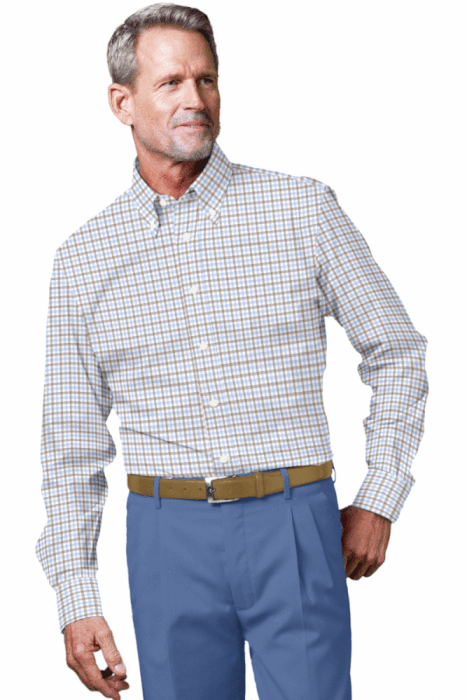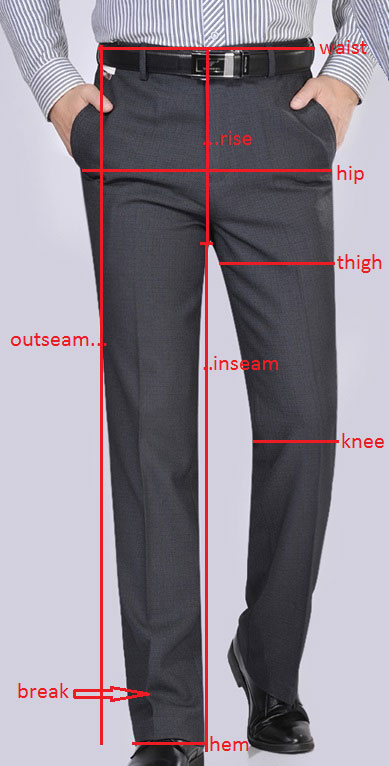How Pants Should Fit

As we stated when we discussed well fitted shirts, you will never be a well-dressed man if your clothes do not fit you properly. Obviously this statement also applies when referring to pants. Like a shirt, pants are another article of clothing that we men wear every day… at least out in public. Also referred to as slacks or trousers this garment is one that serves as the base or foundation for the rest of our outfit. It may not be the lead or star character in your presentation but it certainly is an important supporting actor.
When discussing how pants should fit, one first has to identify what kind of pant we are speaking about. Dress slacks should fit very differently than say jeans, chinos or other casual pants. In general, casual pants tend to be worn tighter and in some cases lower on the hip rather than around the waist – as dress pants should be worn. Secondly, one must obviously consider the physique of the individual. Tall and thin certainly accommodates a different fit than short and heavy. But overall the areas to be addressed to achieve a proper fit are the same.
The Waist – the waist area is the beginning point. Where you wear your pants affects not only your appearance but also your comfort. A well fitted pant will be tight enough around the waist that you do not require a belt to hold them up but not so tight that they are uncomfortable or require an effort to button them up. The lower you wear your pants the shorter your legs will appear and the more your pants will want to drop. You do not want to spend your day repeatedly pulling up your pants.
The Rise – This is the distance from the top of the waist band down to the crotch or opening between the legs. The rise should be longer in dress pants especially when compared to hip hugging tighter jeans.However, if the rise is too long you will have fabric hanging too far down between your legs and this will not only look bad but will make it more difficult to maneuver. If the rise is too short then you will be uncomfortable due to the lack of space, especially when sitting down. Also pants that are too tight in the crotch can have you looking like a male ballet dancer in tights.
The Hip or Seat – This is the widest part of your anatomy below your waist. It is the circumference around your buttocks, hips and crotch. If the pants are too wide in this area you will have excess fabric that will wrinkle and ruin the smooth drape of the pant both in front and back. If the pants are too narrow in this area they will be uncomfortable and will cause the fabric to stretch and pull, again disrupting the natural drape and clean look of the fabric.
The Thigh, Knee and Hem – Determining the width of the pant leg has to do with not only your leg dimensions but also with the proportion to the rest of your body. If you are a larger individual you will not be able to wear the slim pants that a thin man can. However, as long as it is comfortable, limiting the width of the pant legs is recommended. You should be trying to minimize your size and wide pants will defeat that goal.
The Length and Break – The length of your pants is the distance from the top of your waist band to the bottom of your pant leg, known as the outseam. Another measurement that can be taken is from the seam at the bottom of the crotch to the bottom of the pant leg. This measurement is known as the inseam. Determining the proper length is predicated by the degree of a break you are trying to achieve. The break is the fold or bend above the bottom of your pants where the pant leg comes in contact with your shoe. The degree of a breaks are commonly referred to as full, half or medium, quarter or slight and in some cases no break. A full break is the biggest fold or excess length. Half and quarter or of course shorter with less of a break and no break is where the pant leg falls straight and just touches the top of your shoe. Also, the width of the pant bottom affects the proper length as a narrow bottom will restrict the amount of drop when coming in contact with your shoe. Tastes vary but you should avoid being so long that your pant leg bunches up above your shoe or having your pant leg be so short that there is no contact with your shoe and your socks or ankles are exposed.
As always, the best approach to having your clothes fit you properly is to have them custom made. But even if you would rather buy off the peg most body types should be able to find a reasonably good match given all the different fits and styles afforded by the various brands in the market place. Of course a good tailor can also do wonders by making the adjustments you may need. The following illustration should provide an overview of the areas to address in order to achieve a proper fitting pair of pants.

Contact RICARDO for Custom Slacks starting at $369 and Ready to Wear Pants as low as $99
Call to make an appointment
561.370.3552
You will benefit from our meticulous attention to detail, unparalleled customer service, quick turnarounds, and great prices.
Follow RICARDO on Facebook for regular updates
A Guide About the Best Way Pants Should Fit to Look your Best. Learn About the Waist, the Rise, Hip or Seat, Thigh, Knee and Hem, and the Length and Break.
